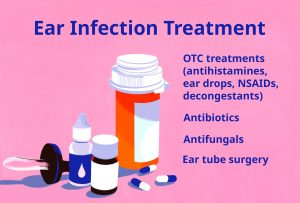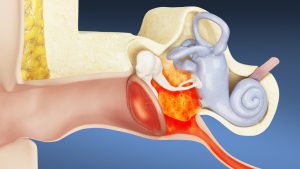
TREATMENTS FOR EAR INFECTIONS
Treatments for ear infections. Both bacteria and viruses can cause ear infections. They can happen in the outer and inner ear, as well as the middle ear, which is the area of the ear directly behind the eardrum. Although they frequently go away on their own, swelling or fluid accumulation can make them painful. Both acute and chronic ear infections are possible. Although they hurt, acute ear infections don’t last long. Ear infections that are chronic either don’t go away or keep coming back. They may result in middle and inner ear damage, which is rarely irreversible.
TREATMENTS FOR EAR INFECTIONS
To diagnose an ear infection, a doctor frequently only needs a device known as a pneumatic otoscope. By using this tool, the physician can examine the ear and determine whether fluid is present behind the eardrum. The doctor gently presses air against the eardrum using the pneumatic otoscope. Normally, the eardrum would move in response to this puff of air. Your doctor will notice little to no movement of the eardrum if the middle ear is filled with fluid.
Treatment at home

The following techniques work well for reducing the signs of a minor ear infection:
• Place a warm cloth over the ear that is afflicted.
• Use over-the-counter pain relievers like Tylenol’s acetaminophen or ibuprofen.
• To relieve pain, apply over-the-counter or prescription ear drops. Decongestants such as pseudoephedrine are available over-the-counter.
• Do not sleep on the ear that is afflicted.
Medical care
Also, consult a physician if your symptoms worsen or remain the same. If your ear infection is bacterial, persistent, or doesn’t seem to be getting better, they might recommend antibiotics. Viral infections cannot be treated with antibiotics.
Children’s medical care

Meanwhile, in order to prevent overprescribing antibiotics, which can result in antibiotic resistance, doctors frequently treat pediatric ear infections by waiting and seeing. If your symptoms are severe or don’t go away in two to three days, your doctor might occasionally prescribe antibiotics. As an alternative, they might write you a prescription but advise you to wait two to three days to see if your child’s symptoms improve. Children should never take aspirin without a doctor’s prescription. One avoidable risk factor for Reyes’ syndrome, a rare condition that damages the liver and brain, is taking aspirin.
Surgery

Although, If the standard medical treatments don’t clear up your ear infection or if you get ear infections frequently in a short period of time, surgery might be your best bet. Ear tubes are typically inserted into your ears to let fluid escape. Your eardrums are surgically opened to accommodate these tubes. The holes eventually heal after they fall out. Occasionally, surgery is required to close these holes.
Prevention

The following behaviors may lower your risk of developing an ear infection:
1. frequent hand washing
2. avoiding crowded places
3. not using pacifiers around babies and young children;
4. breastfeeding babies; avoiding secondhand smoke
5. maintaining current vaccinations
The bacteria or viruses that cause ear infections are found in the middle ear, which is the area of the ear behind the eardrum. The majority of ear infections go away in three days or less, but more serious infections might require antibiotic treatment. Children are most likely to get ear infections. If you or your child experience severe pain, a fever exceeding 102.2°F, ear drainage, or other worrisome symptoms, it’s imperative that you consult a physician.
Summary
A virus or bacteria that infects the area behind your child’s eardrum can cause ear infections, also known as acute otitis media. One of the symptoms is ear pain, which can make your baby or toddler particularly fussy or agitated. Ear infections frequently go away on their own. Children occasionally require ear tubes, antibiotics, or painkillers.